 Facebook
Facebook
 X
X
 Instagram
Instagram
 TikTok
TikTok
 Youtube
Youtube
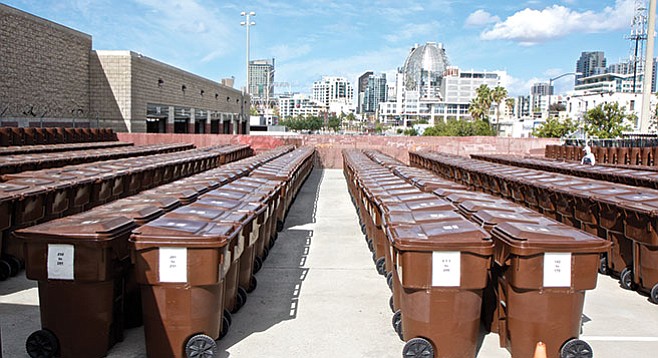
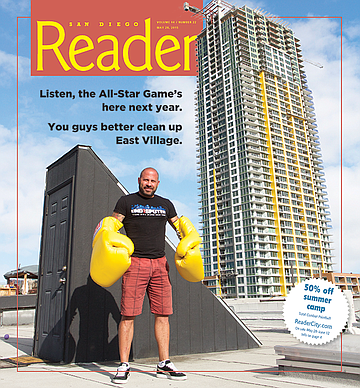
“No one calls me Joel. My mom and my girlfriend. That’s pretty much it.”
So, from here on out we shall refer to Joel Rocco simply as Rocco, the proud owner of Undisputed Boxing in the East Village (along with his two partners, Nestor Flores and Herman Terrado).
The Downtown Undisputed locale is where our story begins. On a Friday afternoon I ventured down to the gym, nestled between 15th and 16th avenues on K Street to talk to Rocco about East Village. The building is an interesting one. The first floor is what you would imagine a typical boxing gym to be — a ring, punching bags, and other training devices I couldn’t name. A general smell of human sweat hung in the air, even though there were exactly zero humans to be found working out. The gym was on its daily break between morning and late-afternoon classes. Rocco took me upstairs to the second level of the building where he and his girlfriend live — a hip loft they share with a large, hyperactive dog whose playful greetings only had me moderately worried.
The golden nugget was the next stop, though. Rocco led me up yet another staircase to the roof of his building. I discovered a sun-drenched party-zone that appeared to be the ultimate man cave minus the whole “cave” deal. There was a lot of bamboo, a barbeque, a keg here and there, and enough open party space to get the E! Network’s attention.
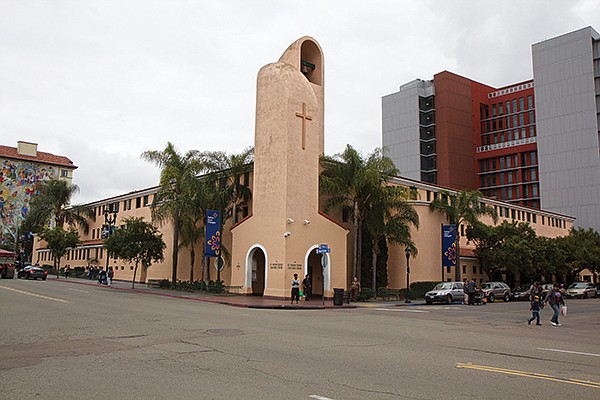
Then I started to peek around a bit, past the rooftop pleasure-center to the buildings and neighborhood surrounding me. An oceanfront homeowner probably wouldn’t describe what I saw as a million-dollar view, but for the sake of this story, it was pretty damn priceless. The components that made up the transitioning nature of the East Village were all there, right before my eyes. The homeless lining the north end of the Padres’ tailgate parking lot at the west end of K Street. The St. Vincent de Paul Joan Kroc Center just a couple blocks to the south, and the massive initial tower of the Pinnacle building under construction just to the northwest of us. Three vital elements in this time of change for the East Village.
The Pinnacle building, under construction, rises over the sidewalk tent community in San Diego's East Village neighborhood.
I didn’t realize it until I was on the roof, but the Undisputed stands firmly in what may be the last free haven for the homeless population in downtown San Diego — an area that Rocco defines as roughly K or J Street to Imperial and from 10th to 17th.
From the roof of Rocco’s building, you can watch the homeless navigating the nearby streets as they go about their daily rituals. It is akin to viewing an extremely depressing and slow-moving game of the 1980s video game Frogger. Once you get down to street level, it gets even bleaker.
A casual walk around these parts on a Friday afternoon is no stroll down a bustling Gaslamp District sidewalk. Businessmen and women are nowhere to be found, the occasional MTS employee or random strolls by, and everyone else is homeless.
You may find yourself between a destitute gentleman and his anxious march to the liquor store you just passed. You may be surprised by the fact that the only method he uses to request money from you is to frantically point at said liquor store. No words necessary. You toss him a quarter because it’s too depressing not to. It’s tough not to feel bad when you’re walking down these streets.
On an unusually warm and sunny day in March, the smell of human piss, puke, and shit is thick in the air. Welcome to the East Village.
“Six years ago, when we first opened, it was a lot worse,” Rocco explained. “A lot more drug activity, but the homelessness has actually stayed just about the same. It might have increased a little bit because of all the building they’ve been doing downtown over the past six years. They’re sort of getting pushed this way.”
He continued, “And you’ve got different categories of the homeless. You’ve got the ones that don’t give two shits, these are these people over here that get their free meals from the place over there, in that little church [points toward St. Vincent de Paul’s Joan Kroc Center on Imperial Avenue]. And then they go and grab their booze from the liquor store, and then they go back over there and they get fed. Repeat process. That’s all they do.”
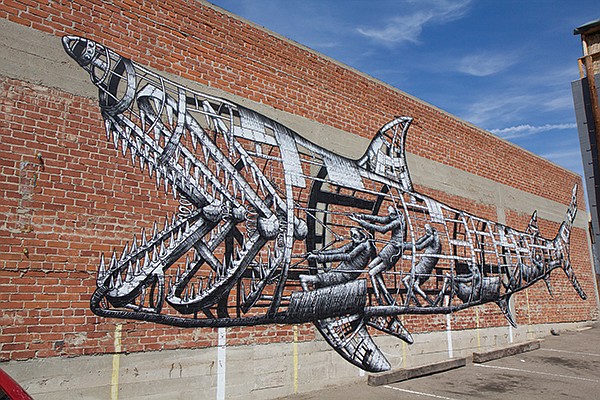
The owner of Undisputed gym, located in San Diego's East Village, shares the considerable view from his rooftop.
Joel Rocco of Undisputed gym shares his loft living space and view into the gym, and then discusses his experience of living near a large population of homeless people.
In mid-January, my friends and I caught a performance by L.A.- based comic Jessimae Peluso at the American Comedy Company in the Gaslamp District. Early in her set, Peluso ranted about how when she went for a walk around the neighborhood, she couldn’t believe how many homeless folks she encountered.
“I felt like I was walking through a cloud of urine,” is the line that I remember most vividly, mainly because I have walked through that same cloud many, many times.
Rocco has the perspective of a business owner and resident who has observed the homeless in his community for six years. Peluso’s comments reflect the general element of appalled surprise that tourists feel when they stumble upon the sadder reality of San Diego’s downtown; a reality that is easy to stumble upon if you venture just slightly off the “safer” confines of the Gaslamp and ballpark areas; a reality that will confront you if you are in town for a convention and decide to add an extra quarter mile to your usual half-mile jog; a reality that has been pushed, seemingly block-by-block, to the east as neighborhoods to the west have redeveloped more rapidly.
“I think, from what I get from my constituents, they feel that it is worse,” San Diego City Council District 3 representative Todd Gloria explained to me during a lengthy phone conversation. “I think that has to do with development pressures elsewhere in downtown. Little Italy, Marina, Gaslamp — all those areas have built up and pushed folks to the east. You also have a number of service providers in East Village, so there’s a natural draw there to begin with."
Gloria offered 1000 as a fair estimate of the average number of homeless individuals in his district on any given day.
“And from my standpoint, it’s 1000 too many,” he added. “The solution is Housing First.”
Housing First is a movement based on the idea that, instead of transitioning gradually from the street to shelters to group homes to individual housing, “the easiest way to solve homelessness is to give someone a home,” Gloria says. “In the past, many times homeless individuals were asked to try and resolve some of the inherent reasons they were homeless before they got a house. So, from that point, if you are a serious alcoholic, you have to get clean and sober before you can get a bed. In my opinion, that’s really cart-before-horse. It’s very difficult to get clean and sober if you’re living on the street. If you have a warm and safe environment, and one that has accompanied services like a social worker, therapist, and some of the things that you need, you’re more likely to actually solve the root cause of homelessness.”
One-thousand free dwellings downtown could be tough to generate, though. In the meantime, another method of assistance Gloria mentioned was the “Homeless Check-In Center located in a parking lot near 16th Avenue and K Street. It’s basically a storage depot for the homeless population.
Inside the storage depot in San Diego's East Village neighborhood where homeless people are able to safely store their belongings.
“Homeless people don’t have homes, but that doesn’t mean they don’t have stuff,” Gloria explained. “East Village residents have been very vocal about their frustrations with having folks storing stuff in the public right of way — on sidewalks, in gutters, that kind of thing. What we have now is a city-owned parking lot that has a bunch of city-owned trash cans and people can store their stuff there. It’s a solution to getting folks’ stuff off the street so the residents are happy. But it reduces some of the conflicts among the homeless because peoples’ stuff is secure; there is no risk of it being stolen from them. Most importantly, it’s really hard to get a job when you have all your worldly possessions on your back, so we’re finding that people are having better outcomes because they can store their stuff there. They can go and interview and, hopefully, get off the streets.”
A promising program and a practical solution to make the daily lives of both the homeless and neighborhood residents a little easier. But the fact remains, large groups of homeless individuals continue to congregate en masse in that sweet-spot Rocco outlined to me during our discussion. They have been pushed east steadily for about ten years now, and it doesn’t feel as if that migration is coming to an end.
“The Padres’ head of security and one of the big wigs on the Padres sits on the board with me — the East Village Association,” Rocco explained. “They were talking about how Bud Selig [Major League Baseball commissioner] was telling them, ‘Listen, the All-Star Game’s here next year (2016). You guys better clean up downtown.’”
So, now it appears Major League Baseball, and not the National Football League, may eventually be the professional sports organization that drives the bulk of the homeless out of downtown.
Not that long ago, the East Village was the talk of the town. The entire region was abuzz about where the new Chargers’ stadium would be located. And if it did move downtown, it looked as if it was going to get plopped down right on top of the epicenter of homelessness, where Undisputed is located. The bull’s-eye was going to be the MTS bus yard, located right across the street from Rocco’s building on K Street — coincidentally, Gloria’s old stomping grounds.
“I worked for the county for a number of years, and some of those years were spent at the MTS building at 12th and Imperial,” Gloria explained. “The county occupies most of it — two floors. And there was nothing down there but the bus yard and the taco shop, and that was about the end of it.”
The area hasn’t been developed as extensively as other parts of the East Village, but there are certainly more obstacles in the path of the stadium than there would have been 20 years ago. And, to top it off, moving the old bus yard may have proved a bit trickier than expected.
“You may have seen the letter from MTS, which owns the bus yard, which is kind of the site that people have in mind. There’s some real practical challenges for doing that there,” Gloria said. “Their answer wasn’t ‘no,’ but it was ‘our best guess is this could take five to seven years to relocate the bus yard and do all kinds of things that are necessary.’ If that’s the case, that doesn’t really fit the Chargers’ timeline. It may just be that it doesn’t work out. What I’ve said is, I wanna keep the Chargers here. If it’s in my district, great. If it’s somewhere else, that’s okay, too.”
The “somewhere else” option is looking pretty likely. On May 18, the Citizens’ Stadium Advisory Group recommended only Mission Valley as the potential location for a new stadium.
So, why did the downtown location lose out? Jason Riggs, chairman of the San Diego Stadium Coalition told me that, from what he has discerned, infrastructure was a major concern — issues such as pedestrian safety and parking. Concerning the latter, he said that since most Chargers games would be on Sundays, fans could park all over a somewhat deserted downtown (at least compared to the workweek). And for those fans pleased with the Mission Valley choice because it will preserve Qualcomm’s robust tailgating culture... don’t get your hopes up.
“I do know that JMI [the downtown stadium location development firm] has some amount of tailgating baked into their plan,” Riggs said. “We even talked about potentially opening up Petco, the little beach area, and letting folks hang out there before games. There’s a lot of options because it’s right next to Petco and they, of course, have a tailgate lot as well....
“The MTS report, in my opinion, included an extremely long timeline and, even from a pure financial perspective, I know they padded it with some contingency money,” Riggs said. “The plan actually increased in cost to the tune of $50 million over a couple of years [from] when they proposed moving it a couple years earlier. So, yeah,” he laughs, “you can take all that for what it’s worth. But those are the facts.”
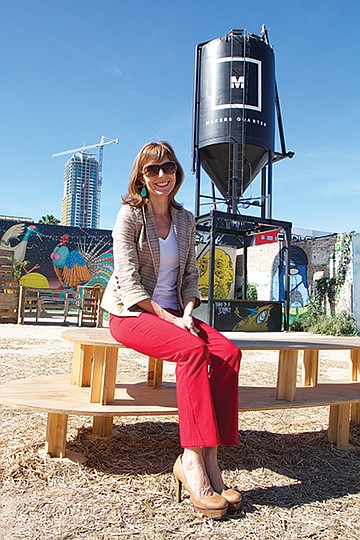
Stacey Pennington, an urban planner spearheading the new Makers Quarter district in the northeastern portion of the neighborhood, had mixed feelings about the East Village stadium location from the start. And considering her credentials — master’s degree in urban planning from Harvard — she’s one to listen to.
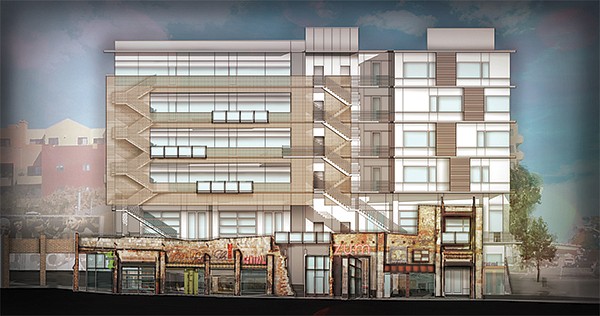
“Frankly, I’m conflicted about it,” Pennington told me over the phone. “I see the tremendous opportunity to create, as long as it is active year-round, a thriving entertainment district of sorts. That’s the pro. The con is just the wanting to learn more about how scale of that size could really work within the existing infrastructure of our downtown. I actually did a scale comparison, a graphic one a couple years ago when they first started talking about this — just looking up the plan of the most recent urban/urban-edge stadiums and then overlaying them onto this site. I’m sure more has been done since I did that quick analysis, but it’s definitely tight.”
It surprised me that Pennington was the only person I talked to who acknowledged that the actual space for the stadium might not have been there from the start. It’s pretty tough to imagine Qualcomm occupying that spot in the East Village. When I was overlooking the potential stadium site from the roof of Rocco’s building, it didn’t seem nearly large enough. A large chunk of downtown, besides the MTS bus yard, would have to be bulldozed to make room for that stadium.
Odds are that the East Village will avoid one massive upheaval by losing the stadium bid, but even so, the story doesn’t end there. Gloria summed up the situation by saying: “The stadium conversation has been an interesting one because even if they placed it there, there would still be a tremendous amount of development available in the East Village. How many other places could you say that of?"
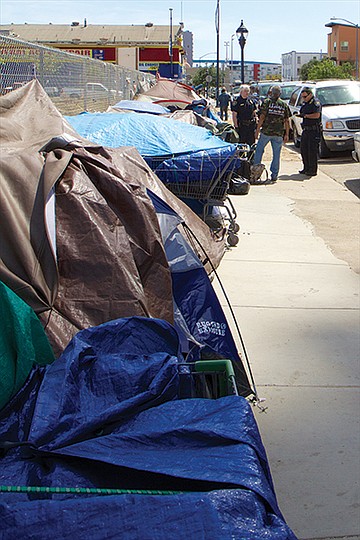
The Pinnacle building, perhaps the most difficult landmark in the neighborhood not to notice these days — is the high-rise, Return of the Jedi Death Star under construction in the East Village. The Pinnacle, located at 15th and J Street, will be 100 percent rentals. Plus, remember that Housing First program Todd Gloria mentioned? Ten percent of the Pinnacle’s 965 apartments will be Section 8. So, in a perfect scenario, a homeless guy or gal who spent their afternoons watching the Pinnacle building’s slow rise to the heavens could eventually end up living there.
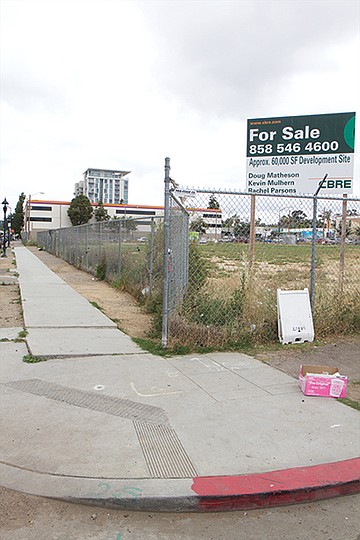
As far as construction goes, the future of the East Village sounds as if it is heading up — as in, to the sky. The Pinnacle tower will soon be joined by its twin and even more enormous apartment complexes intent on shaking hands with God.
Well, maybe not everything will be gigantic.
“It will be low-, midand high-rise,” is how Gloria explains it. “You’ll see stuff like Union Square, which is across from the police station. It has been there for a decade or more. It’s several stories. You have Pinnacle, which is going up, the Makers Quarter idea, the variety of buildings at different heights — some pretty tall, some less tall.”

The Makers Quarter concept is being spearheaded by the aforementioned (and self-proclaimed “nerdy urban planner”) Stacey Pennington. The general location for the project is the area that falls between 17th to 14th avenues and Broadway to G Street. Out of those 12 blocks, six are being developed by Makers Quarter. These are blocks in which the Navarra family (of Jerome’s Furniture fame) owned parcels of land they wished to have developed.
“They selected the team [several years ago] that I’m on to help them develop it, so that it could really create a sense of community and a neighborhood,” Pennington said. “Right away we just started the process of kind of stripping back the layers to even looking at a lot of the details about the history of the site and the area, to be in touch with what was unique about this particular part of the East Village and downtown.”
One of their most visible creations is Silo, a community gathering space located at the corner of 16th Avenue and F Street. The walls are covered with murals by local artists. Guests sit on wooden benches, and a black silo proudly displays the moniker. So far, the spot has hosted events held by local nonprofits and out-of-towners, such as Google and Yelp.
Pennington feels that the space is meant to engage locals but also to communicate “the awesomeness of San Diego and the East Village to a broader audience.” Pennington oversees the East Village Green (a planned neighborhood park), a collaborative office hub on 15th Avenue and F Street, and a mixed-use residential high-rise project called Broadstone.
Visiting the landmarks of Maker's Quarter in San Diego's East Village neighborhood, including the SILO outdoor event space, SMARTS Farm, and Bradley Mountain's manufacturing space.
As of now, there is no plan for a strip of bars and restaurants in the neighborhood à la 30th Street in North Park or Garnet Avenue in Pacific Beach.
“When I was a kid, 30th Street wasn’t much to look at, right?” Gloria recalled. “And I think even ten years ago, no one would have predicted that it would have become the nation’s best beer boulevard [as Men’s Journal named 30th Street in 2009]. It just came to be. That’s one of the crazy things about East Village, is that much of its future is still in development, and it’s so large that it can really accommodate a number of things.”
He added, “I think these things often are organic. Something will go in on one of those corners that is just gangbusters, and that will attract others.”
Rocco feels that the area will have a North/ South Park–type of feel, “But with high-rises.” He has commissioned artists to add visual flair to the sides of his building, and is quick to speak highly of the artists’ colony located behind it.
“I think it’s gonna be like the East Village of New York. Artsy,” he added.
Perhaps the best way to come to grips with the changing nature of this neighborhood is to take a look into its past. Stacey Pennington did just that when she started work on Makers Quarter.
“In these couple of blocks [between 17th and 14th, and then Broadway to G Street] you had the influence of the industrial activity going on closer to the shipyards and the bay coming up north,” she said. “There, you would see a lot of warehouses and those types of buildings, but, before the freeway, it was also a natural extension of Golden Hill. So, mixed in between those warehouse buildings were beautiful Victorian homes. You can kind of still see that crazy mixture in a couple of the blocks now, but I found a few historic photos where you could really see that. A really interesting convergence between the growing residential and the growing industrial.”
Annie Navarra, who grew up with her family running the initial Jerome’s location in the East Village, sent me this vivid description of her memories of the neighborhood: “My earliest recollection of East Village was in 1952. It was definitely a commercial area with some private homes and apartment buildings. Market Street and Broadway were the two busiest streets.
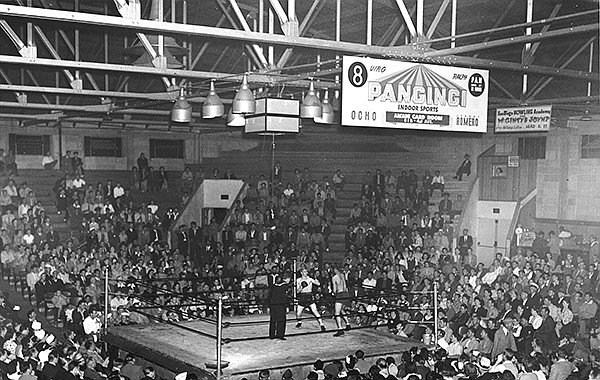
“The San Diego Coliseum was the home to boxing and wrestling. Archie Moore and Ken Norton were two well-noted boxers [who fought there]. Gorgeous George was a popular wrestler in the 1950s. It was our original sports arena. “San Diego City College and San Diego High School were the only schools. City College had vocational schools on 14th and 15th avenues.
“The San Diego Department of Weights and Measures was on the corner of 15th Avenue and F Streets. I remember Casey Pontiac was located at 14th and Broadway, and there was a bowling alley on E Street between 14th and 15th avenues. The building that was owned by Grandfather Girolamo on 14th where our father and two partners opened the first furniture-discount warehouse in San Diego was previously a horse stable for the fire department.
“Sears & Roebuck had a warehouse on the corner of 14th & E Street. The most beautiful building in my estimation was owned by the State of California and rented to the Blind Institute where brooms were manufactured. It was a beautiful red brick structure. The big treat for us was when our father took us to the Bohemian Bakery located on Market Street. It was a Jewish deli that was always full of happy and hungry patrons. Also on West Market Street was McDinty’s Corn Beef House.”



“No one calls me Joel. My mom and my girlfriend. That’s pretty much it.”
So, from here on out we shall refer to Joel Rocco simply as Rocco, the proud owner of Undisputed Boxing in the East Village (along with his two partners, Nestor Flores and Herman Terrado).
The Downtown Undisputed locale is where our story begins. On a Friday afternoon I ventured down to the gym, nestled between 15th and 16th avenues on K Street to talk to Rocco about East Village. The building is an interesting one. The first floor is what you would imagine a typical boxing gym to be — a ring, punching bags, and other training devices I couldn’t name. A general smell of human sweat hung in the air, even though there were exactly zero humans to be found working out. The gym was on its daily break between morning and late-afternoon classes. Rocco took me upstairs to the second level of the building where he and his girlfriend live — a hip loft they share with a large, hyperactive dog whose playful greetings only had me moderately worried.
The golden nugget was the next stop, though. Rocco led me up yet another staircase to the roof of his building. I discovered a sun-drenched party-zone that appeared to be the ultimate man cave minus the whole “cave” deal. There was a lot of bamboo, a barbeque, a keg here and there, and enough open party space to get the E! Network’s attention.

Then I started to peek around a bit, past the rooftop pleasure-center to the buildings and neighborhood surrounding me. An oceanfront homeowner probably wouldn’t describe what I saw as a million-dollar view, but for the sake of this story, it was pretty damn priceless. The components that made up the transitioning nature of the East Village were all there, right before my eyes. The homeless lining the north end of the Padres’ tailgate parking lot at the west end of K Street. The St. Vincent de Paul Joan Kroc Center just a couple blocks to the south, and the massive initial tower of the Pinnacle building under construction just to the northwest of us. Three vital elements in this time of change for the East Village.
The Pinnacle building, under construction, rises over the sidewalk tent community in San Diego's East Village neighborhood.
I didn’t realize it until I was on the roof, but the Undisputed stands firmly in what may be the last free haven for the homeless population in downtown San Diego — an area that Rocco defines as roughly K or J Street to Imperial and from 10th to 17th.
From the roof of Rocco’s building, you can watch the homeless navigating the nearby streets as they go about their daily rituals. It is akin to viewing an extremely depressing and slow-moving game of the 1980s video game Frogger. Once you get down to street level, it gets even bleaker.
A casual walk around these parts on a Friday afternoon is no stroll down a bustling Gaslamp District sidewalk. Businessmen and women are nowhere to be found, the occasional MTS employee or random strolls by, and everyone else is homeless.
You may find yourself between a destitute gentleman and his anxious march to the liquor store you just passed. You may be surprised by the fact that the only method he uses to request money from you is to frantically point at said liquor store. No words necessary. You toss him a quarter because it’s too depressing not to. It’s tough not to feel bad when you’re walking down these streets.
On an unusually warm and sunny day in March, the smell of human piss, puke, and shit is thick in the air. Welcome to the East Village.
“Six years ago, when we first opened, it was a lot worse,” Rocco explained. “A lot more drug activity, but the homelessness has actually stayed just about the same. It might have increased a little bit because of all the building they’ve been doing downtown over the past six years. They’re sort of getting pushed this way.”
He continued, “And you’ve got different categories of the homeless. You’ve got the ones that don’t give two shits, these are these people over here that get their free meals from the place over there, in that little church [points toward St. Vincent de Paul’s Joan Kroc Center on Imperial Avenue]. And then they go and grab their booze from the liquor store, and then they go back over there and they get fed. Repeat process. That’s all they do.”

The owner of Undisputed gym, located in San Diego's East Village, shares the considerable view from his rooftop.
Joel Rocco of Undisputed gym shares his loft living space and view into the gym, and then discusses his experience of living near a large population of homeless people.
In mid-January, my friends and I caught a performance by L.A.- based comic Jessimae Peluso at the American Comedy Company in the Gaslamp District. Early in her set, Peluso ranted about how when she went for a walk around the neighborhood, she couldn’t believe how many homeless folks she encountered.
“I felt like I was walking through a cloud of urine,” is the line that I remember most vividly, mainly because I have walked through that same cloud many, many times.
Rocco has the perspective of a business owner and resident who has observed the homeless in his community for six years. Peluso’s comments reflect the general element of appalled surprise that tourists feel when they stumble upon the sadder reality of San Diego’s downtown; a reality that is easy to stumble upon if you venture just slightly off the “safer” confines of the Gaslamp and ballpark areas; a reality that will confront you if you are in town for a convention and decide to add an extra quarter mile to your usual half-mile jog; a reality that has been pushed, seemingly block-by-block, to the east as neighborhoods to the west have redeveloped more rapidly.
“I think, from what I get from my constituents, they feel that it is worse,” San Diego City Council District 3 representative Todd Gloria explained to me during a lengthy phone conversation. “I think that has to do with development pressures elsewhere in downtown. Little Italy, Marina, Gaslamp — all those areas have built up and pushed folks to the east. You also have a number of service providers in East Village, so there’s a natural draw there to begin with."
Gloria offered 1000 as a fair estimate of the average number of homeless individuals in his district on any given day.
“And from my standpoint, it’s 1000 too many,” he added. “The solution is Housing First.”
Housing First is a movement based on the idea that, instead of transitioning gradually from the street to shelters to group homes to individual housing, “the easiest way to solve homelessness is to give someone a home,” Gloria says. “In the past, many times homeless individuals were asked to try and resolve some of the inherent reasons they were homeless before they got a house. So, from that point, if you are a serious alcoholic, you have to get clean and sober before you can get a bed. In my opinion, that’s really cart-before-horse. It’s very difficult to get clean and sober if you’re living on the street. If you have a warm and safe environment, and one that has accompanied services like a social worker, therapist, and some of the things that you need, you’re more likely to actually solve the root cause of homelessness.”
One-thousand free dwellings downtown could be tough to generate, though. In the meantime, another method of assistance Gloria mentioned was the “Homeless Check-In Center located in a parking lot near 16th Avenue and K Street. It’s basically a storage depot for the homeless population.
Inside the storage depot in San Diego's East Village neighborhood where homeless people are able to safely store their belongings.
“Homeless people don’t have homes, but that doesn’t mean they don’t have stuff,” Gloria explained. “East Village residents have been very vocal about their frustrations with having folks storing stuff in the public right of way — on sidewalks, in gutters, that kind of thing. What we have now is a city-owned parking lot that has a bunch of city-owned trash cans and people can store their stuff there. It’s a solution to getting folks’ stuff off the street so the residents are happy. But it reduces some of the conflicts among the homeless because peoples’ stuff is secure; there is no risk of it being stolen from them. Most importantly, it’s really hard to get a job when you have all your worldly possessions on your back, so we’re finding that people are having better outcomes because they can store their stuff there. They can go and interview and, hopefully, get off the streets.”
A promising program and a practical solution to make the daily lives of both the homeless and neighborhood residents a little easier. But the fact remains, large groups of homeless individuals continue to congregate en masse in that sweet-spot Rocco outlined to me during our discussion. They have been pushed east steadily for about ten years now, and it doesn’t feel as if that migration is coming to an end.
“The Padres’ head of security and one of the big wigs on the Padres sits on the board with me — the East Village Association,” Rocco explained. “They were talking about how Bud Selig [Major League Baseball commissioner] was telling them, ‘Listen, the All-Star Game’s here next year (2016). You guys better clean up downtown.’”
So, now it appears Major League Baseball, and not the National Football League, may eventually be the professional sports organization that drives the bulk of the homeless out of downtown.
Not that long ago, the East Village was the talk of the town. The entire region was abuzz about where the new Chargers’ stadium would be located. And if it did move downtown, it looked as if it was going to get plopped down right on top of the epicenter of homelessness, where Undisputed is located. The bull’s-eye was going to be the MTS bus yard, located right across the street from Rocco’s building on K Street — coincidentally, Gloria’s old stomping grounds.
“I worked for the county for a number of years, and some of those years were spent at the MTS building at 12th and Imperial,” Gloria explained. “The county occupies most of it — two floors. And there was nothing down there but the bus yard and the taco shop, and that was about the end of it.”
The area hasn’t been developed as extensively as other parts of the East Village, but there are certainly more obstacles in the path of the stadium than there would have been 20 years ago. And, to top it off, moving the old bus yard may have proved a bit trickier than expected.
“You may have seen the letter from MTS, which owns the bus yard, which is kind of the site that people have in mind. There’s some real practical challenges for doing that there,” Gloria said. “Their answer wasn’t ‘no,’ but it was ‘our best guess is this could take five to seven years to relocate the bus yard and do all kinds of things that are necessary.’ If that’s the case, that doesn’t really fit the Chargers’ timeline. It may just be that it doesn’t work out. What I’ve said is, I wanna keep the Chargers here. If it’s in my district, great. If it’s somewhere else, that’s okay, too.”
The “somewhere else” option is looking pretty likely. On May 18, the Citizens’ Stadium Advisory Group recommended only Mission Valley as the potential location for a new stadium.
So, why did the downtown location lose out? Jason Riggs, chairman of the San Diego Stadium Coalition told me that, from what he has discerned, infrastructure was a major concern — issues such as pedestrian safety and parking. Concerning the latter, he said that since most Chargers games would be on Sundays, fans could park all over a somewhat deserted downtown (at least compared to the workweek). And for those fans pleased with the Mission Valley choice because it will preserve Qualcomm’s robust tailgating culture... don’t get your hopes up.
“I do know that JMI [the downtown stadium location development firm] has some amount of tailgating baked into their plan,” Riggs said. “We even talked about potentially opening up Petco, the little beach area, and letting folks hang out there before games. There’s a lot of options because it’s right next to Petco and they, of course, have a tailgate lot as well....
“The MTS report, in my opinion, included an extremely long timeline and, even from a pure financial perspective, I know they padded it with some contingency money,” Riggs said. “The plan actually increased in cost to the tune of $50 million over a couple of years [from] when they proposed moving it a couple years earlier. So, yeah,” he laughs, “you can take all that for what it’s worth. But those are the facts.”

Stacey Pennington, an urban planner spearheading the new Makers Quarter district in the northeastern portion of the neighborhood, had mixed feelings about the East Village stadium location from the start. And considering her credentials — master’s degree in urban planning from Harvard — she’s one to listen to.

“Frankly, I’m conflicted about it,” Pennington told me over the phone. “I see the tremendous opportunity to create, as long as it is active year-round, a thriving entertainment district of sorts. That’s the pro. The con is just the wanting to learn more about how scale of that size could really work within the existing infrastructure of our downtown. I actually did a scale comparison, a graphic one a couple years ago when they first started talking about this — just looking up the plan of the most recent urban/urban-edge stadiums and then overlaying them onto this site. I’m sure more has been done since I did that quick analysis, but it’s definitely tight.”
It surprised me that Pennington was the only person I talked to who acknowledged that the actual space for the stadium might not have been there from the start. It’s pretty tough to imagine Qualcomm occupying that spot in the East Village. When I was overlooking the potential stadium site from the roof of Rocco’s building, it didn’t seem nearly large enough. A large chunk of downtown, besides the MTS bus yard, would have to be bulldozed to make room for that stadium.
Odds are that the East Village will avoid one massive upheaval by losing the stadium bid, but even so, the story doesn’t end there. Gloria summed up the situation by saying: “The stadium conversation has been an interesting one because even if they placed it there, there would still be a tremendous amount of development available in the East Village. How many other places could you say that of?"

The Pinnacle building, perhaps the most difficult landmark in the neighborhood not to notice these days — is the high-rise, Return of the Jedi Death Star under construction in the East Village. The Pinnacle, located at 15th and J Street, will be 100 percent rentals. Plus, remember that Housing First program Todd Gloria mentioned? Ten percent of the Pinnacle’s 965 apartments will be Section 8. So, in a perfect scenario, a homeless guy or gal who spent their afternoons watching the Pinnacle building’s slow rise to the heavens could eventually end up living there.

As far as construction goes, the future of the East Village sounds as if it is heading up — as in, to the sky. The Pinnacle tower will soon be joined by its twin and even more enormous apartment complexes intent on shaking hands with God.
Well, maybe not everything will be gigantic.
“It will be low-, midand high-rise,” is how Gloria explains it. “You’ll see stuff like Union Square, which is across from the police station. It has been there for a decade or more. It’s several stories. You have Pinnacle, which is going up, the Makers Quarter idea, the variety of buildings at different heights — some pretty tall, some less tall.”

The Makers Quarter concept is being spearheaded by the aforementioned (and self-proclaimed “nerdy urban planner”) Stacey Pennington. The general location for the project is the area that falls between 17th to 14th avenues and Broadway to G Street. Out of those 12 blocks, six are being developed by Makers Quarter. These are blocks in which the Navarra family (of Jerome’s Furniture fame) owned parcels of land they wished to have developed.
“They selected the team [several years ago] that I’m on to help them develop it, so that it could really create a sense of community and a neighborhood,” Pennington said. “Right away we just started the process of kind of stripping back the layers to even looking at a lot of the details about the history of the site and the area, to be in touch with what was unique about this particular part of the East Village and downtown.”
One of their most visible creations is Silo, a community gathering space located at the corner of 16th Avenue and F Street. The walls are covered with murals by local artists. Guests sit on wooden benches, and a black silo proudly displays the moniker. So far, the spot has hosted events held by local nonprofits and out-of-towners, such as Google and Yelp.
Pennington feels that the space is meant to engage locals but also to communicate “the awesomeness of San Diego and the East Village to a broader audience.” Pennington oversees the East Village Green (a planned neighborhood park), a collaborative office hub on 15th Avenue and F Street, and a mixed-use residential high-rise project called Broadstone.
Visiting the landmarks of Maker's Quarter in San Diego's East Village neighborhood, including the SILO outdoor event space, SMARTS Farm, and Bradley Mountain's manufacturing space.
As of now, there is no plan for a strip of bars and restaurants in the neighborhood à la 30th Street in North Park or Garnet Avenue in Pacific Beach.
“When I was a kid, 30th Street wasn’t much to look at, right?” Gloria recalled. “And I think even ten years ago, no one would have predicted that it would have become the nation’s best beer boulevard [as Men’s Journal named 30th Street in 2009]. It just came to be. That’s one of the crazy things about East Village, is that much of its future is still in development, and it’s so large that it can really accommodate a number of things.”
He added, “I think these things often are organic. Something will go in on one of those corners that is just gangbusters, and that will attract others.”
Rocco feels that the area will have a North/ South Park–type of feel, “But with high-rises.” He has commissioned artists to add visual flair to the sides of his building, and is quick to speak highly of the artists’ colony located behind it.
“I think it’s gonna be like the East Village of New York. Artsy,” he added.
Perhaps the best way to come to grips with the changing nature of this neighborhood is to take a look into its past. Stacey Pennington did just that when she started work on Makers Quarter.
“In these couple of blocks [between 17th and 14th, and then Broadway to G Street] you had the influence of the industrial activity going on closer to the shipyards and the bay coming up north,” she said. “There, you would see a lot of warehouses and those types of buildings, but, before the freeway, it was also a natural extension of Golden Hill. So, mixed in between those warehouse buildings were beautiful Victorian homes. You can kind of still see that crazy mixture in a couple of the blocks now, but I found a few historic photos where you could really see that. A really interesting convergence between the growing residential and the growing industrial.”
Annie Navarra, who grew up with her family running the initial Jerome’s location in the East Village, sent me this vivid description of her memories of the neighborhood: “My earliest recollection of East Village was in 1952. It was definitely a commercial area with some private homes and apartment buildings. Market Street and Broadway were the two busiest streets.

“The San Diego Coliseum was the home to boxing and wrestling. Archie Moore and Ken Norton were two well-noted boxers [who fought there]. Gorgeous George was a popular wrestler in the 1950s. It was our original sports arena. “San Diego City College and San Diego High School were the only schools. City College had vocational schools on 14th and 15th avenues.
“The San Diego Department of Weights and Measures was on the corner of 15th Avenue and F Streets. I remember Casey Pontiac was located at 14th and Broadway, and there was a bowling alley on E Street between 14th and 15th avenues. The building that was owned by Grandfather Girolamo on 14th where our father and two partners opened the first furniture-discount warehouse in San Diego was previously a horse stable for the fire department.
“Sears & Roebuck had a warehouse on the corner of 14th & E Street. The most beautiful building in my estimation was owned by the State of California and rented to the Blind Institute where brooms were manufactured. It was a beautiful red brick structure. The big treat for us was when our father took us to the Bohemian Bakery located on Market Street. It was a Jewish deli that was always full of happy and hungry patrons. Also on West Market Street was McDinty’s Corn Beef House.”
Comments